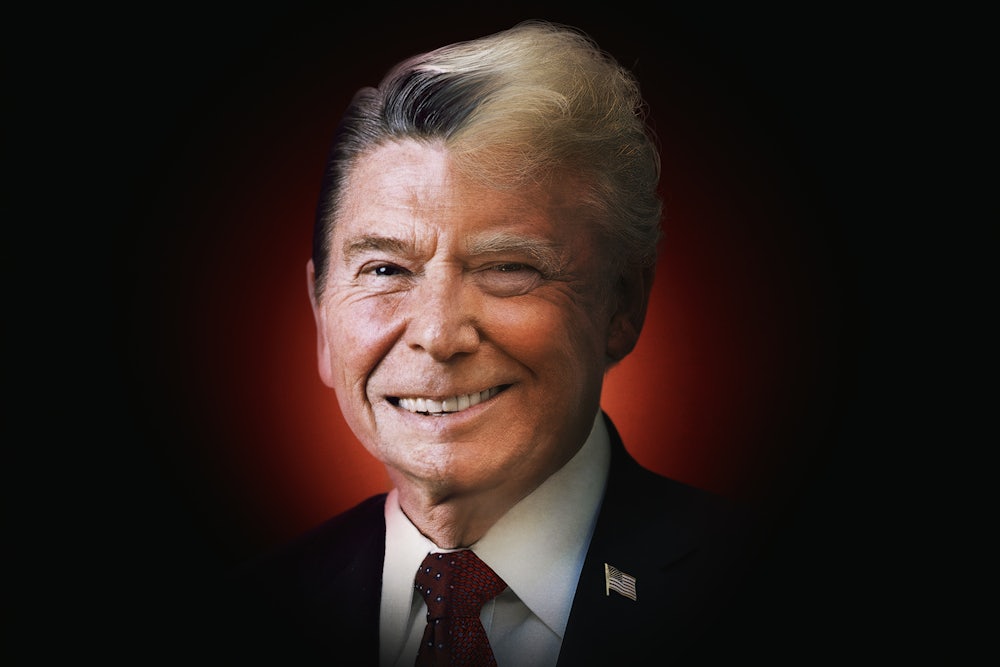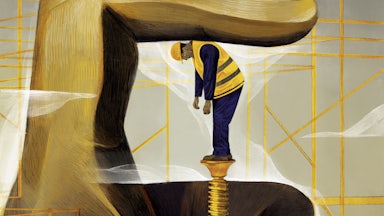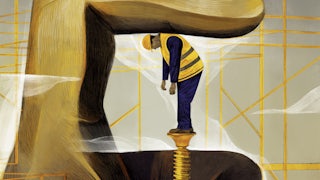No one has been more baffled by Ronald Reagan than the scholars who have devoted their lives to making sense of his. The book still hailed as the most definitive biography, Lou Cannon’s 1991 President Reagan, is more a journalist’s account of Reagan’s presidency than a full-scale life of the man. Reagan’s authorized biographer, Edmund Morris, found himself so flummoxed by his subject that he wound up placing himself in the narrative as a character in his 1999 Dutch (Reagan’s childhood nickname).
Political theorist Michael Rogin’s 1987 Ronald Reagan, The Movie suggests one reason Reagan has proved such a difficult subject: As a political leader, he “collapsed the distinctions” between fantasy and real life. Reagan saw himself as though he were a character in a Hollywood film, engaged in heroic battle against shadowy foes—an embodiment of what Rogin described as the “countersubversive tradition” in American politics. “Unlike any other president since the end of World War II,” Rogin wrote, “Reagan has succeeded in making himself the benign center of America and placing malignancies outside our borders.” How is the biographer—who seeks to place his or her subject in historical context, to frame the meaning of a life, to dispel myths and put controversies to rest—to handle a leader whose appeal lay in his capacity to blur the border of fiction and reality?

The latest writer to try the life of Reagan is Max Boot, whose attraction to Reagan is both entirely understandable and a bit of a surprise. Boot was born in the Soviet Union; his family immigrated to California when he was a young child. Boot is well-known for his advocacy of neoconservative foreign policy ideas—he backed wars in Afghanistan and Iraq enthusiastically—but the rise of Donald Trump has made him bemoan “the corrosion of conservatism” (the title of a 2018 book) and question the politics to which he had committed his life.
Reagan: His Life and Legend is the product of that internal debate. At its heart is the question of whether Reagan is responsible for the rise of Trumpism. Were there similarities between Reagan and Trump that Boot missed earlier? Did one pave the way for the other? Boot seems intent on showing that he is not presuming sympathy toward his former political hero, promising to offer a “fair-minded” account of Reagan, drawing on declassified documents and almost 100 interviews with Reagan associates to write a biography that is neither “a hagiography or a hit job.”
Given this research, though, it’s remarkable how closely Boot manages to repeat what has become the common wisdom on Reagan’s relation to MAGA and Trump. The greatest surprise, he suggests, is Reagan’s “pragmatism”: His “strongly held principles” were tempered by a “keen sense of realpolitik.” Boot reaffirms the general conclusion that Reagan was very different from Trump in both policy and style. The fortieth president was a “consummate gentleman who never indulged in name-calling or acerbic put-downs,” an instinctive democrat who would “never have dreamed” of instigating an insurrection to stay in office. Perhaps, he concedes, Reagan bent the truth to his own wishes in ways that mirror Trump’s pathological lies. But the differences matter more.
It is true that Trump and Reagan are very different. But their contrast cannot be explained primarily in terms of character, and the gap between the two men reflects the broader transformation of American conservatism and American society in the years since the 1980s. Reagan cannot be understood outside of the framework of Cold War conservatism. To an extent unusual in electoral politics, Reagan was a social movement leader, his ideas about the state, social movements, labor unions, and democracy itself shaped by his involvement in the right-wing mobilization that swelled in the aftermath of World War II. As midcentury conservatives confronted the challenge of labor unions and the New Deal state, they had to put forward a populist case for free markets in terms that presented them—not big government—as the way to provide prosperity for all. They labored to distance themselves from the nativist and antisemitic preoccupations of earlier generations in a play for respectability and to pursue a role in mainstream politics, even as they continued to cultivate this base of support when it suited them to do so.
One of the things that distinguishes Trump from Reagan is that, today, the right can be far more open in its antagonism toward democratic politics—and it no longer needs to insist that the market can offer wealth and abundance to the whole of society. While Trump may not have emerged out of a political movement as Reagan did, he has helped to call into being one focused on nationalism and a conspiratorial politics in ways quite different from the midcentury right. But this is not a temperamental difference between Trump and Reagan as individuals: Trump’s politics point to the larger transformation of American society, brought about by the changes unleashed by 1980s America.
Reagan’s life began in the small towns of the Midwest. He was the second child of a devout Christian mother with a strong self-dramatizing streak and an alcoholic father who found intermittent work as a shoe salesman. Like many other Reagan biographers, Boot suggests that Reagan’s emotional distance and acute dislike for interpersonal conflict were the result of his fraught family dynamics—all classic hallmarks of being the child of an alcoholic. Faced with unpleasant realities, he would instead insist that reality was as he wanted it to be. As his mother advised him, it was best always to stay on the “sunny side” of life. Boot describes Reagan’s time as a high school lifeguard and his days at Eureka College (a small Christian school in Illinois) during the Depression, where he made a foray into student activism and participated in a student strike to save programs that were threatened by budget cuts. Had he not wanted to become an actor so desperately, Boot explains, Reagan might have married his college sweetheart and settled into life as a Midwestern middle manager. (Boot dismisses the rumor that Reagan’s college girlfriend got pregnant and either had an abortion or gave the child up for adoption.)
Instead, Reagan went to Hollywood—as did many Midwesterners and Southerners in the 1930s and 1940s, bringing the cultural conservatism of their hometowns to the decadent sunshine of California. In his first years as a movie actor, he was entirely within the liberal fold. He became president of the Screen Actors Guild and campaigned for Truman in 1948. Even by that time, however, he had become deeply involved with anti-communist politics. It started with splits within liberal groups that Reagan feared were being taken over by leftists. Then—during a fierce conflict between a progressive CIO-style labor union of studio employees and an old-school craft union in the industry—Reagan (listening to the studio owners and craft unionists) became convinced that there was an ongoing “Communist putsch for control of motion pictures.” From there, the rest was inevitable: He became a friendly witness to HUAC and gave names of suspected Reds to the FBI. While he was president of the Screen Actors Guild, the executive secretary of the union turned the files of members with suspected ties to the Communist Party over to the FBI, which Boot suggests is hard to imagine happening without Reagan’s knowledge and tacit support, and Reagan himself told agents that he would help in the cause of “purging the motion picture industry of Communists.” He supported the idea of a federal law to make joining the party illegal.
For Boot, all this is a sign of Reagan’s deepening involvement in an anti-communist underworld of paranoiacs and loonies. But this dismissive stance undercuts the significance of this episode, or the intensity of conflict over the postwar world. Hollywood in the late 1940s was in fact a politically contested space, for the unions, the studios, and for the terms of cultural production. This was not directed puppeteer-style by Moscow, but it is no accident (as the old Marxists would say) that Hollywood labor and cultural politics would become the staging ground for Reagan’s lifelong fixation on the Soviet Union: There really was a bitter struggle in Hollywood, and throughout the country, over the shape of the nation in the postwar years.
The same issues were at play during Reagan’s time at General Electric, where he went in 1954. Throughout the late 1940s and 1950s, GE practiced a charged labor politics, where management committed to fighting the unions at the company after a bitter strike in 1946; they viewed labor issues at the electrical manufacturer as a microcosm of the political weakness of business. The leaders of GE handed out conservative reading materials (such as John T. Flynn’s The Road Ahead) and encouraged supervisors to hold reading groups to discuss free-market thought. They hired Reagan to host the weekly television program General Electric Theater on CBS and to speak to line workers at plants across the country; he would often meet with local chambers of commerce and Rotary Clubs to talk with business leaders.
In these speeches, he honed his political message, warning of the dangers of what later conservatives would call the deep state, “a permanent structure of government beyond the reach of Congress and actually capable of dictating policy” that for him defined totalitarianism. He decried socialized medicine and argued in the charged, melodramatic rhetoric of the Cold War: “We have 10 years … to win or lose—by 1970 the world will be all slave or all free.” This was the language that he used when he gave a fundraising dinner speech for the Goldwater campaign in 1964. The attendees loved it so much that the campaign bought a half-hour of television time so he could give the speech to the nation. Subsequently, a small group of California businessmen (who would become known as the “Kitchen Cabinet”) decided that they would back Reagan for governor in 1966. For American businessmen—especially the small manufacturers, affluent suburbanites, and disgruntled Southerners who were the base of the Goldwater movement—the federal bureaucracy, national labor unions, and the civil rights movement represented, as Reagan put it, an “encroaching control” on their power, even if they were not in reality the front guard of the Soviet Union, as the John Birch Society warned.
Reagan brought these ideological fixations into his time as governor of California. He took power in the state at a moment when it had an unusually dynamic and expansive government, represented especially by its tuition-free, top-notch public university system. The universities were Reagan’s number one enemy. Student radicals, in his view, embodied the perils of youthful countercultural excess and the bloated public sector. Higher education, as he said of Berkeley, had become a “refuge for communism and immorality.” Opposition to liberal academia allowed Reagan to marry his earlier focus on government and labor to the cultural politics of the late 1960s, to attack “beatniks and advocates of sexual orgies, drug usage, and filthy speech” along with leftist professors who “indoctrinate and propagandize” against “the traditional values of a free society.” His attacks on the Great Society served the same function, as when he denounced that “segment of society” that preferred “freeloading at the expense of more conscientious citizens.”
And Reagan—like most midcentury conservatives—had little use for the civil rights movement. He bristled at any suggestion that he himself might harbor personal prejudice, repeatedly insisting, absent any evidence in the historical record, that as a radio announcer in the 1940s he had been an outspoken advocate for the desegregation of baseball. Regardless of the truth of this claim, in the 1960s he argued that the civil rights movement spread social disorder, disrespect for authority, and contempt for private property. Commenting on the killing of Martin Luther King Jr. in 1968, Reagan described it as a “great tragedy that began when we began compromising with law and order and people began choosing which laws to obey”—suggesting that there was a line that led from civil disobedience to assassination, that King’s actions might have led to his own death. He denounced the extension of the Voting Rights Act as “pure cheap demagoguery” that would lead “a new wave of carpetbaggers” to violate the political independence of the South, as in Reconstruction.
In the 1960s, he echoed George Wallace when warning that the United Nations—which included “some sixty new and very uneducated Nations such as the new African States”—could claim authority to intervene against Jim Crow. He later complained to Richard Nixon about “those monkeys from African countries” who were “still uncomfortable wearing shoes,” but who had the temerity to cross the will of the United States (voting to seat a delegate from mainland China over one from Taiwan in the U.N. General Assembly). “When they have a man for lunch, they really have him for lunch,” he joked about African habits to Black Republican Edward Brooke in 1965. All of this may frame his later skepticism about support for the anti-apartheid movement of the 1980s.
But as troubling as such comments may be, the key is that Reagan was not alone: In his discomfort with civil rights and his dislike of the United Nations, he spoke for a political movement of small businessmen and prosperous suburbanites, defense manufacturers and affluent professionals, whose economic and racial fears were closely aligned, and who saw in these challenges to racial hierarchy, both domestically and internationally, a danger not only to their pocketbooks but to their broader sense of social order. When Reagan ran for the presidency—first in 1976, when he mounted a primary challenge to Gerald Ford, and then in 1980, when he campaigned against Jimmy Carter—this was the constituency that he was able to galvanize.
The last major part of Boot’s book turns to Reagan’s presidency, and here he seems to be shadowboxing with Reagan’s critics and acolytes. Was Reagan hardworking or lazy, a warmonger or a peacemaker, a man who was on top of his presidency or someone easily manipulated? There’s much that is interesting in these last sections, and yet Boot fails to give a sense of what might seem most important to grapple with today: the fate of Reagan’s conservative movement in the 1980s.
For the social groups that had propelled him forward were in fact in crisis by the time that Reagan was elected. On the surface, there was an array of wins: Anti-communism was still the guiding force of the movement, and in office Reagan was able to continue to crusade against the Soviet Union and to make a play for U.S. primacy in international politics, endangered by defeat in Vietnam. He saw a world that was slipping from the grip of U.S. dominance, in Latin America, in the Middle East, in Central Asia, and he was prepared to commit massive amounts of federal spending on military weapons to win it back. Almost immediately upon entering office he vastly increased aid to El Salvador (seeing it as “the place for a victory”) in an effort to stop the Caribbean from becoming a “Red lake.” At the same time, Reagan was able to use his time in office to undercut what he had long seen as the excessive power of unions, most dramatically in his firing of the air traffic control workers when they went on strike in 1981, which legitimated the use of striker replacements throughout U.S. industry. And he cut top marginal rates and capital gains taxes, reshaping the tax system in ways that linger to this day.
These changes would help to propel the economic transformation of the country in the 1980s. The small manufacturers who had powered the midcentury right were in decline. The bull market of the 1980s, the surging technological changes emerging out of Northern California, and the continued lifting of trade barriers and accelerating departure of industry from the North and Midwest (especially during the recession of the early 1980s) all altered the economic dynamics. Finance and tech alike threw up new billionaires, people wealthy on a vast new scale.
Meanwhile, within Reagan’s administration, the different factions fought bitterly: the libertarians who sought to privatize government and shrink the state, the Cold War hawks who wanted more money for Star Wars, the evangelicals who hoped Reagan would appoint more judges who would be hostile to abortion. There were deep conflicts within the conservative world that came out clearly once it was in power. Boot captures a little bit of this (as in his discussions of Iran-Contra, which pitted Reagan loyalists who worried about protecting the president from engaging in possibly illegal acts against those who saw fomenting anti-communism around the world as an absolute priority). But for the most part his chapters on Reagan’s presidency are too overwhelmed by the pace of events to really offer an interpretation that captures the changing dynamics of the conservative movement—or of the country over these years, as the polarization of wealth we are so familiar with today began to emerge, and as once-prosperous cities and towns entered into a slump from which they have yet to fully recover.
Historians such as John Ganz and Nicole Hemmer have argued that the roots of MAGA can be found in the detritus of the 1980s and 1990s. Its origins are in those elements of the far right that crept back into public life once the pressures of the Cold War and anti-communism dissipated. Racism, xenophobia, and antisemitism could once more be used as potent political tools, defining a sinister enemy threatening the virtuous United States. People living in small towns that were emptying out and in midsize cities where the jobs had dried up were eager for someone to blame. The erosion of labor unions, stable work, and local institutions has created fertile ground for the flourishing of the right. So has a growing population of veterans of the war on terrorism who come back to a nation that has little use or respect for them—but who have military skills and who have grown used to seeing themselves as warriors for the nation, as scholar Kathleen Belew has suggested. And the very people who won most dramatically in the economy remade by Reagan—the tech billionaires, the finance bros, the Elon Musks and Peter Thiels—could embrace the sheer asociality of Trump’s politics, the way that it divides the world starkly between winners and losers, the strong and the weak. One could go on, but there are many ways that American society today might seem more open to a far-right mobilization than it did when Reagan built his career on the GE speaker circuit.
The victories of Reagan’s style of conservatism opened the way for these changes, by creating the conditions for the relentless accumulation of wealth and acceleration of the economic divide that are so critical to the reservoir of support for the far right. They helped, too, to build the military up again, in ways that would help to spur the Iraq War and the war on terrorism. Despite the obvious programmatic differences between Reagan and Trump on matters such as free trade and immigration, their politics share a veneration of business, of entrepreneurialism, a celebration of the market, a contempt for civil servants and bureaucrats, for the entire ideal of collective action. Although Reagan is praised now for his optimism and good cheer, he often leaned into melodramatic warnings of impending doom. Certainly, Trump brings out a crudeness and violence that was anathema to the propriety of the midcentury right—but the call to arms was certainly present for the earlier conservatism, too, even in its more “respectable” corners.
Perhaps it is a sign of the times that the strongest, most interesting angle of Boot’s book explores Reagan’s relationships with the women in his life—which appear as one of the real contrasts with Trump. The Reagan that emerges in these pages was often clueless about the inner lives of those around him. He was stunned when after college his longtime sweetheart dumped him, and was equally dumbfounded when his first wife, the movie star Jane Wyman, announced she was leaving him. Boot describes Reagan in the aftermath of his divorce from Wyman as a Hollywood playboy, seducing legions of the starstruck girls who came to California. “I tried to go to bed with every starlet in Hollywood. And I damn near succeeded,” he later reflected.
Nancy Reagan started out like the rest—an actress girlfriend, not someone about whom he was immediately serious. But then they got married—Boot suggests that Nancy was likely pregnant first and that this precipitated the engagement—and she was willing to devote herself entirely to caring for him, placing his needs first and prioritizing them absolutely as she would for the rest of his life. They called each other “Mommie Poo Pants” and “Daddie Poo Pants,” writing each other innumerable love letters from the road.
Despite the intimacy between Ronnie and Nancy, the Reagan family was tense. The parents never seemed to have space for their children and had great difficulty seeing them as independent or autonomous beings with interests of their own. Reagan’s two children from his marriage to Wyman were outsiders in his new family. Confronted with this in later life, Reagan apparently responded, “We were happy. Just look at the home movies.” But in contrast to Trump’s crass sexism, Reagan’s relationship with Nancy is affecting, even acknowledging the anxiety that drove her fixation on her dress size (she couldn’t tolerate gaining weight) and her unending commitment to Ronnie. Perhaps one of the differences between the midcentury right and MAGA is that the earlier conservatism seemed to have a world it sought to preserve—as hierarchical as it may have been—whereas today, the right seems bent on destruction, compelled only by fantasy and rage.




